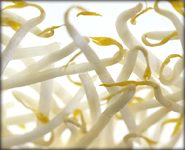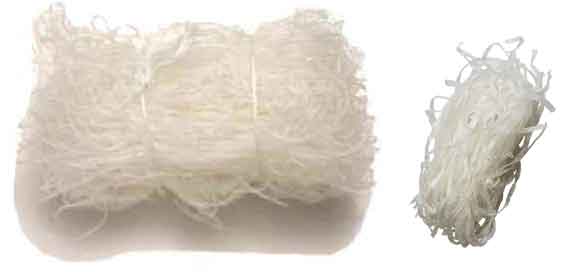 Subscribe to my feed for ingredients
Subscribe to my feed for ingredients  Add to My Yahoo
Add to My Yahoo 
© Copyright 1995-2023, Clay Irving <clay@panix.com>, Manhattan Beach, CA USA
 Subscribe to my feed for ingredients
Subscribe to my feed for ingredients  Add to My Yahoo
Add to My Yahoo
Cellophane Noodle Characteristics
Pronounced: SEHL-uh-fayn
Cellophane noodles are translucent, thread-like noodles and are also known as "bean threads", "mung bean threads", "bai fun", "translucent noodles", "shining noodles", "slippery noodles", "peastarch noodles, powdered silk noodles, saifun, sai fun, silver noodles, Chinese vermicelli, "transparent noodles", "fen szu", "fen si", "fan si", "fun see", "glass noodles", "crystal noodles", "jelly noodles", "transparent vermicelli", "soo hoon" or "sohoon" (Cantonese), "su boon", "tung boon", "su un" (Indonesian), "pancit sotanghon" (Tagalog), "woon sen" (Thai), "bun tau", "mien" or "bun tao" (Vietnamese), "bean thread vermicelli", "green bean thread noodles", "invisible noodles", "pekyasan", "vermicelli noodles", "tanghoon" (Malaysia), "mung pea noodles", and "sotanghon" (Philippines). I wonder if the number of different names for cellophane noodles is any indication of their popularity in Asia?
Cellophane noodles are made from flour made from green mung bean paste. Most people in the US have no idea what mung beans are, but they probably see a form of mung bean everytime they visit the grocery store -- Mung beans are used for bean sprouts!
 | 
|
| Green Mung Beans | Bean Sprouts |
Varieties

|